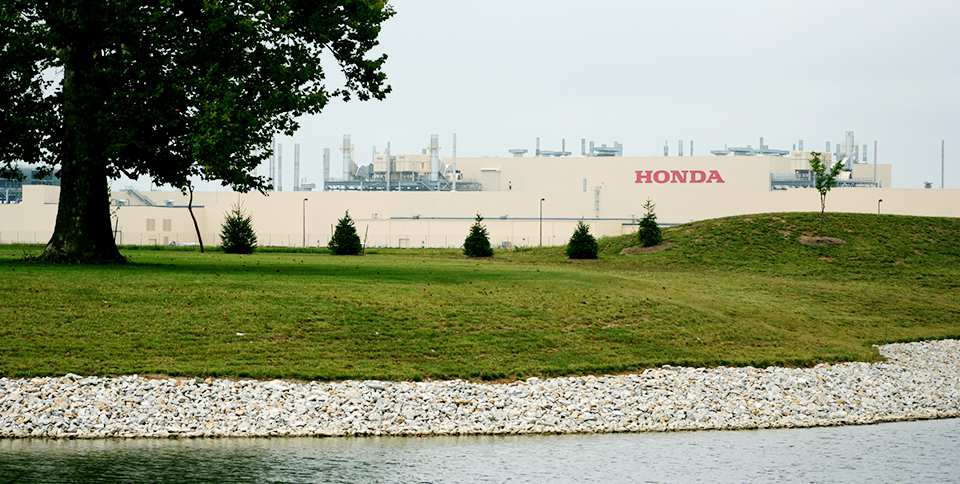News
Three Honda Manufacturing Plants Earn EPA ENERGY STAR Certification

Feb 3, 2016—MARYSVILLE, Ohio
For the tenth consecutive year, two of Honda's Ohio automobile manufacturing plants have earned the U.S. Environmental Protection Agency's (EPA's) ENERGY STAR certification, while Honda Manufacturing of Indiana achieved the designation for the fourth year in a row.
The ENERGY STAR certification signifies that the facilities perform in the top 25 percent of similar facilities nationwide for energy efficiency and meet strict energy efficiency performance levels set by the EPA. On average, ENERGY STAR certified plants consume 35 percent less energy and contribute 35 percent fewer greenhouse gas emissions than similar non-certified operations.
"Every Honda facility considers the energy efficiency of its operations, but especially in our manufacturing plants as these operations can consume so much energy," said Karen Heyob, who leads Honda's environmental sustainability initiatives in North America. "We have found that progress in this area comes when we involve every associate in the process, and not relying on someone with a certain job or responsibility to handle it. When everyone involved considers energy efficiency and how they can help the environment, results improve."
Despite previously earning nine consecutive ENERGY STAR certifications, Honda of America Mfg.'s auto assembly plants in Marysville and East Liberty, Ohio both continued to find new and innovative ways to conserve energy in 2015. The Marysville plant incorporated LED lighting, high-efficiency HVAC systems and direct-fired water boilers when constructing a new 138,000-square foot consolidation center. The plant also introduced new tow motors and forklifts powered by hydrogen fuel cells that reduced propane emissions. The 2.8-million square-foot East Liberty plant installed new LED lighting, replaced a large water heater with a n high-efficiency one, and will have new high-efficiency 1350-ton chillers in service in 2016.
Honda Manufacturing of Indiana LLC, which at seven years of operation is Honda's newest plant in the United States, has been ENERGY STAR certified for each of the last four years. The plant, located in Greensburg, Indiana, continued its goal of energy efficiency by transitioning to LED high-bay lighting in 2015, while using the Honda North America green factory assessment tool to guide the design and construction of a recently-completed expansion to incorporate energy efficient features where possible.
ENERGY STAR was introduced by EPA in 1992 as a voluntary, market-based partnership to reduce greenhouse gas emissions through energy efficiency. Today, the ENERGY STAR label can be found on more than 65 different kinds of products, 1.4 million new homes, and 20,000 commercial buildings and industrial plants that meet strict energy-efficiency specifications set by the EPA. Over the past twenty years, American families and businesses have saved more than $230 billion on utility bills and prevented more than 1.8 billion metric tons of greenhouse gas emissions with help from ENERGY STAR.
For more information about ENERGY STAR Certification for Industrial Facilities: www.energystar.gov/labeledbuildings
About Honda's Environmental Commitment
Based on its vision of "Blue Skies for our Children," Honda is working to advance technologies that address society's environmental and energy concerns. The company's "Green Path" approach seeks to reduce or eliminate the use of substances of concern (SOCs) and scarce natural resources in the design of its vehicles, significantly reduce the CO2 intensity and water use of its manufacturing operations, continue to decrease CO2 emissions from the transportation of vehicles from its plants to dealers, and expand the involvement of U.S. Honda and Acura dealers in its "Green Dealer" program.
In keeping with its commitment to produce vehicles with the lowest CO2 emissions at plants with the smallest environmental footprint, the company is broadly addressing emissions, energy, water use and waste in all phases of its products life cycles. In the manufacturing realm, this includes a 95 percent reduction in waste sent to landfills in North America. Honda is working to extend its "green factory" and "green purchasing" initiatives to its more than 650 parts suppliers in North America and is also pursuing more environmentally responsible business practices among its U.S. dealers.
These activities reinforce Honda's goal to voluntarily reduce its total corporate CO2 emissions by 50 percent by the year 2050, compared to 2000 levels. In 2006, Honda was the first auto company to voluntarily and publically commit to global reductions in its CO2 emissions.
Error: You currently have access to a subset of X API V2 endpoints and limited v1.1 endpoints (e.g. media post, oauth) only. If you need access to this endpoint, you may need a different access level. You can learn more here: https://developer.x.com/en/portal/product